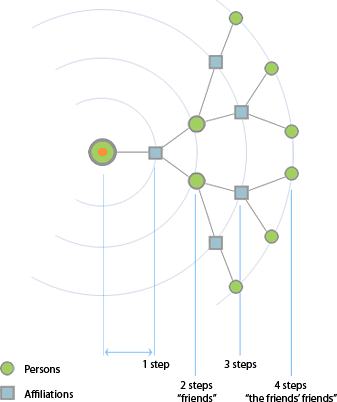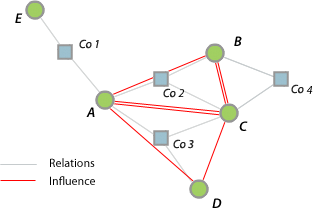General Introduction
An Introduction to Networks
"Networking" is the buzz word of our times, networks are all around us. Networks are the key to our life – virtually anything is connected with something other: Persons, corporations and their share holders, our private and public life. Any structure that emerges from the mutual ties of its components may be conceived as a network.
The very purpose of network analysis – and Network Monitor in particular – is to make these networks visible, to unveil the hidden structures, which are slumbering below the surface of our everyday life.
With this little primer we want to introduce to you some important key terms, which will help you to use Network Monitor.
Ties and Distances in a Network
Network Monitor Austria shows the network of the key players of Austria's industries. This network is formed by the managers and members of the board of the top corporations and their institutional relations to the boards and executive offices of competitive and befriended firms. This way corporations become linked together by their interlocking managers and persons become connected by these affiliations.
The path from a corporation (or affiliation) to another is made up of persons, the ties between persons are made up of affiliations. These step-stones of mutual relations are known as steps:

This illustration gives you a cut detail of the relations of a fictive person:
- This person is a manager or a member of the board of a fictive corporation.
This corporation is one step away from this person. - Working with this corporation our manager meets other executives or members of the board, with whom he's participating in the highs and lows of a manager's life.
These "friends" are to be found 2 steps from him (related by the affiliation common to them). - These "friends" are also related to other firms. (Our manager will possibly talk to them, will be informed about their whereabouts, will honor the sorrows of his colleges.)
These affiliations are 3 steps away.
If some of his "friends" share relations to such affiliations, so these affiliations are what they have in common. - The "friends' friends" are typical addressees of recommendations and references. These can be found in 4 steps' range from our manager.
(The extent of a good networker's 4-step environment may be of remarkable size.)
Influence and Proximity in Networks
By these relations persons and affiliations are more or less tightly integrated into the networks.
Are any persons sharing relations to the same affiliation, they also have something in common. They have common "friends" in these corporations (and by this also common friends of friends). Their mutual influence grows as they share more, but also they become more and more dependent upon each other: They have to get along.
This way the proximity between some players grow, while others become comparatively isolated:

The illustration depicts the network of five players, of whom four of them (A, B, C, D) are linked by shared relations (via corporations 2 and 3).
B and C are also linked by another shared relation (via corporation 4, but we will leave this out further in order to simplify things).
The lines of influence made up by this are depicted as red triangles.
Corporations 2 and 3 are said to be bridgers to players A, B, and C as they are establishing their shared relations.
Vice versa players A, B, and C are bridgers to corporations 2 and 3.
Player E is left quite isolated from this sub-network, but he's also linked to it by player A (via corporation 1), who may broker informations forth an back.
Due to these varying densities of relations some of the actors gain weight of influence: They become ambassadors, who are brokering between the various parts of the network, they are more tightly integrated, have more influence than others. — Integration is a fine thing, but there are times when it's not the best thing to be integrated to closely: Are all of your friends also your friends' friends, you become more and more dependent on them as they form a clique. On the other hand, as you reach into different parts of the network, you may come up with new ideas and opportunities ...
To get a grasp on these various proximities, weights of influence, and opportunities network analysis has developed some elaborate scales and measures – so called network indices – to express these qualities.
You will find these indices, as they have been specially prepared by FAS.research, in the report on the individual players (persons as well as affiliations) alongside with benchmarks and graphical representations.